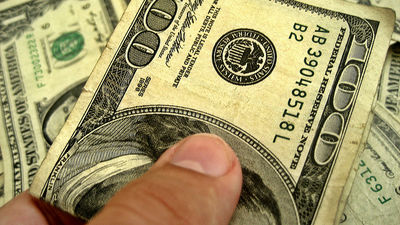I tried to play the maniac economic simulation 'Sim CB' that increases the GDP of the village by impersonating the central bank and setting appropriate interest rates

' Sim CB ' is a simulation game that adjusts the flow of money and people by becoming a central bank and controlling interest rates. I actually played this game where you can visually learn about the economy through the game.
Benoit Essiambre
To play the game, go to the Sim CB page and click Start.

You can see how you are actually playing in the video below. It's a very simple game with no audio and the player can only control interest rates. We control the distribution of apples by designating interest rates and continue to raise GDP (gross domestic product) until a certain period of time has passed.
The economic agents that appear in this game are displayed on the left side of the screen. The central bank is in the center of the upper part. On the left are 10 houses, each of which can accommodate up to 3 workers. The orchard is on the right. At the bottom center is the apple market. The number displayed in the upper left is the number of months elapsed, and the number displayed in the upper right is GDP.

By clicking on each, you can see how many people are in the house, what the orchard is like, and how many apples are on the market.

You can change the 'interest rate' from -0.50% to 50% by 0.25 points with the up and down buttons.

The various rates displayed on the right side of the screen are Natural rate , Apple price, Unemployment, Production: apples per month. , Production: coins worth per month, Wage: per month, Inflation, Menu costs .

Also, at the bottom of the screen, you can check the log of events that occurred in the village and the price transition of apples.

The Sim CB economy is moving on a monthly basis. Every month, people work, orchards produce, apples go to the market, and people get a share of coins to buy apples at the market.
The orchard has 60 months as one cycle, the first 6 months are the planning stage, 24 months are the cultivation / growth stage, and 30 months are the production / harvest stage. Of these, capital investment will be made during the planning, cultivation, and growth stages, so the number of 'coins' in the village will decrease. Profit is only generated at the production / harvest stage. In addition, 1 out of 10 gardens will always be in the 'planning stage' or 'CLOSED' state.

The interest rate at the start of the game is set at 2.0%. People in this village have a certain spending tendency, and every month they pay X% of their coins to buy Y% of the apples that the market has. Y is fixed. When interest rates go down, X goes up proportionally and vice versa. This calculation is done at an inflation-adjusted rate, so the higher the inflation rate, the more people will consume. More specifically, when interest rates are low, economic activity becomes active and the economy goes up, and when interest rates are high, the economy goes down.
At first, the game progresses at 2.0% without any problems, but various events occur during the game. For example, in the following event, the event 'The village has been hit by a drought. Production will decrease by 12%' occurs. As the total number of apples in the market is expected to decrease and the price of apples is expected to rise, we must lower interest rates and increase people's willingness to consume.

When apple production ceases and the apple market is almost out of stock, it will be difficult to stabilize the situation as the resumption of production in the orchards will cause large fluctuations in inventory and prices. This phenomenon is known as the
Orchards also constantly estimate their potential profitability from interest rates set by players and wages and apple prices. Each orchard calculates what the maximum wage can be paid to a worker each month without going bankrupt. Wages are negotiated at the beginning of the life cycle and fixed for 60 months. The orchard you are currently running will go bankrupt if your maximum wage falls below what you previously negotiated.
As a hint to prevent bankruptcy, the approximate maximum interest rate that the least profitable orchard can tolerate before it goes bankrupt is shown as the 'natural rate of interest', and if you set the interest rate higher than this, the orchard goes bankrupt. However, it has been shown that there is a risk of rising unemployment rates.

Lowering interest rates will allow orchards to afford to raise wages, wages will gradually adjust higher, more money will circulate with extra borrowing to pay those wages, and prices will rise little by little.
The game is over 240 months after the game starts. The total number of apples produced so far is displayed.

Related Posts:







